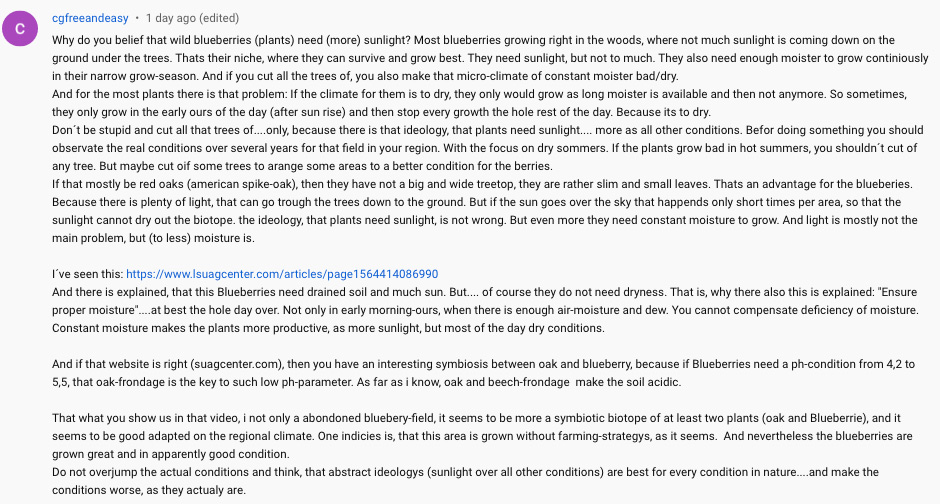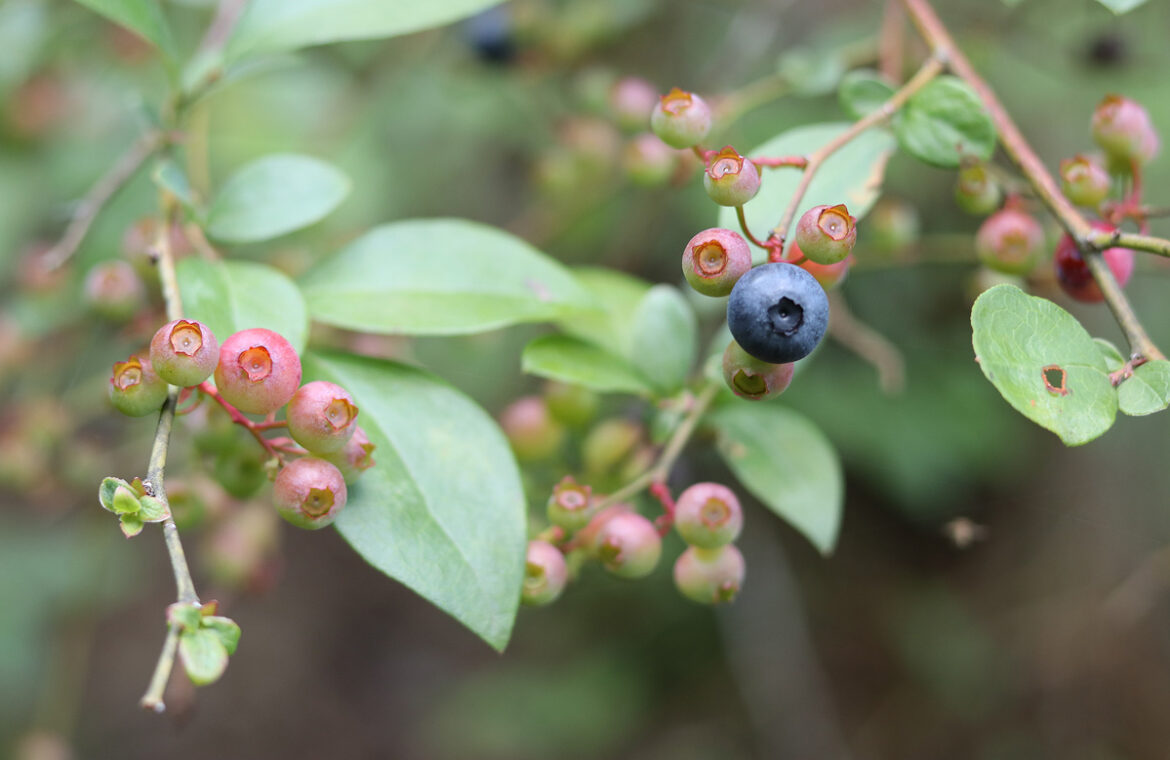cgfreeandeasy makes the erroneous assumption that I’m not thinking through my tree-cutting over the blueberries discovered at the edge of our homestead:
“Why do you belief that wild blueberries (plants) need (more) sunlight? Most blueberries growing right in the woods, where not much sunlight is coming down on the ground under the trees. Thats their niche, where they can survive and grow best. They need sunlight, but not to much. They also need enough moister to grow continiously in their narrow grow-season. And if you cut all the trees of, you also make that micro-climate of constant moister bad/dry. And for the most plants there is that problem: If the climate for them is to dry, they only would grow as long moister is available and then not anymore. So sometimes, they only grow in the early ours of the day (after sun rise) and then stop every growth the hole rest of the day. Because its to dry. Don´t be stupid and cut all that trees of….only, because there is that ideology, that plants need sunlight…. more as all other conditions. Befor doing something you should observate the real conditions over several years for that field in your region. With the focus on dry sommers. If the plants grow bad in hot summers, you shouldn´t cut of any tree. But maybe cut oif some trees to arange some areas to a better condition for the berries. If that mostly be red oaks (american spike-oak), then they have not a big and wide treetop, they are rather slim and small leaves. Thats an advantage for the blueberies. Because there is plenty of light, that can go trough the trees down to the ground. But if the sun goes over the sky that happends only short times per area, so that the sunlight cannot dry out the biotope. the ideology, that plants need sunlight, is not wrong. But even more they need constant moisture to grow. And light is mostly not the main problem, but (to less) moisture is. I´ve seen this: https://www.lsuagcenter.com/articles/page1564414086990 And there is explained, that this Blueberries need drained soil and much sun. But…. of course they do not need dryness. That is, why there also this is explained: “Ensure proper moisture”….at best the hole day over. Not only in early morning-ours, when there is enough air-moisture and dew. You cannot compensate deficiency of moisture. Constant moisture makes the plants more productive, as more sunlight, but most of the day dry conditions. And if that website is right (suagcenter.com), then you have an interesting symbiosis between oak and blueberry, because if Blueberries need a ph-condition from 4,2 to 5,5, that oak-frondage is the key to such low ph-parameter. As far as i know, oak and beech-frondage make the soil acidic. That what you show us in that video, i not only a abondoned bluebery-field, it seems to be more a symbiotic biotope of at least two plants (oak and Blueberrie), and it seems to be good adapted on the regional climate. One indicies is, that this area is grown without farming-strategys, as it seems. And nevertheless the blueberries are grown great and in apparently good condition. Do not overjump the actual conditions and think, that abstract ideologys (sunlight over all other conditions) are best for every condition in nature….and make the conditions worse, as they actualy are.”
Here’s the original comment, on my video about opening up the canopy over wild blueberry bushes via coppicing and pollarding the woods:

And here’s the video:
cgfreeandeasy is making the mistake of underestimating my analysis of the situation.
He assumes stupidity and that I am simply using a blanket “plants need sunlight!” approach.
First of all, my IQ is significantly higher than the general population, despite my folksy approach to YouTube. If I’m doing something that you cannot understand, assuming I have not thought it through is a mistake.
And of course there is no blanket approach for plant cultivation. Different species require different care.
In the case of these blueberries in the woods, cutting the overstory trees to let in more light was based on two things.
FIRST: direct observation of wild blueberries in our region
I spent a lot of time hunting blueberries around the property we rented before purchasing our current homestead.
There, I noted that blueberries completely beneath the canopy bore little to no fruit, whereas shrubs at the edge of the woods, along pathways, fields, etc., were filled with fruit.
A difference of just ten or twenty feet of depth into the woods made a drastic reduction in berry production. Yes, blueberries would fruit at the edge of the woods, with some shade, but in full shade, their yields declined precipitously – sometimes to zero.
These were the same species of wild rabbiteye blueberries, growing in a similar plant community.
Also, I noticed on our land that the blueberries were not productive in the woods under deep shade.
SECOND: Randall White’s story from childhood
In the video, I share an anecdote that Randall White shared from his childhood, that after the local woods were logged, the production of blueberry bushes that had been under the canopy skyrocketed the next yield, giving them a great wild harvest. This is a data point. Far from basing my selective thinning of the woods on some nonsensical idea that “sunlight over all other conditions” is the key, I based my pruning on the KNOWLEDGE that sunlight under these conditions was very likely to improve yields, both from my direct observation and from those of a friend who grew up in the same county, with the same blueberry and oak species.
And don’t forget SUCCESSION!
One final note on the blueberries: ecosystems evolve to their climax state through a process called “succession,” where certain species colonize and thrive for a time, only to be replaced by others later in the system’s development. It may be quite possible that these blueberries are an early colonizer (which is what I believe), and are now being supplanted by trees that have overgrown their original domain.
Without disturbance, these earlier colonizers may end up completely displaced, except along the edges – which, I note from observation of the area – are more densely populated with thickly branched blueberry bushes.
Without a fire or some sort of clearing, they are likely in decline. My selective opening of a portion of the canopy should put them back into the game.
Conclusion
My informed decision to raise the sunlight levels on this patch of wild blueberries will be proven right or wrong by their behavior in the coming year or two. If they make more fruit, my guess was right. If they don’t, I was wrong.
Yet even if I’m wrong, it wasn’t through some stupid application of some rule someone else made up that I got stuck in my head.
We’ll wait and see what happens.


3 comments
I have also found wild blueberries under a canopy of basically the overgrown portion of the lot I am on and am also nearby to you. I’m following Randall closely also. We’ve selectively been removing basically invasives and will add fruiting producers in the area. We selected bare root types for the most part and am waiting on the order. I appreciate that you assimilate knowledge, then decide what works for you or not. Think outside of the box. The blueberry bushes I found were not producing either, except the one by the edge –the sidewalk. I decided to take some of the older canes out of a couple to see if the pruning helps. I also coppiced a couple of small trees to allow the ones that will be newly planted some light. I also watched your video with the blueberry you pick a few times and am putting in 2 new blueberry plants near my garden area. I did add organic matter and pine bark, sulfur etc. to those 2 spots. we had to dig out pebbles and clay — fill dirt in the yard. Thanks for sharing.
I belong to a local small woodlands association and they and the state extension service are good sources for information on forest management and special forest products.
When we thin out and reduce the canopy to let younger trees come up, it also releases the Himalaya blackberries that can grow into thickets and choke out or hide anything else growing in the under story. Some people will run their cattle in the woods in the summer when the cows will enjoy the shade, and they will keep a lot of the brush down. As a side benefit of grazing the cows in the summer, it seems to encourage the spring wildflowers by reducing the competing brush. No idea how that would affect your wild blueberries, though.
I will pass you some unsolicited advice though: Dad had a firm stance that saw chaps are cheaper than trips to the emergency room. He decided that after nicking himself on the knee and needing 40 stitches. When I was young (and before Dad bought me chaps with the firm admonition to use them always) I used to cut firewood in sneakers and ear muffs, with no chaps, no helmet or safety glasses. Of course, no one wore them then. I make sure to wear boots and the chaps now, and a helmet if I am dropping anything because of the risk of falling branches.
I have seen the same thing – where we used to live, there was a thick wooded area behind our house, then one year a small section of it was logged. The summer after, and for many subsequent summers, blueberry bushes appeared and produced prolifically. We had walked the trail that led through that area many times and never seen blueberries there, until the trees were removed. I also suspected this was an incidence of succession, and that some small unproductive blueberry plant had taken off once enough sunlight was able to penetrate.
But I hope you don’t feel like you need to justify the method behind your gardening decisions every time someone leaves a stupid comment about how you’re doing it wrong.
Comments are closed.